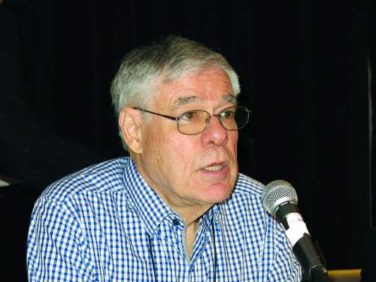A sharp increase in Islamic State sympathizers plotting against U.S. targets occurred after a communiqué circulated widely on the radical Internet called for waging jihad against the United States in retaliation for the bombing of ISIS positions.
The recent attack in Chattanooga, Tenn., on two military facilities in which four Marines and one Naval Academy midshipman were killed has the hallmarks of such a lone wolf attack. Muhammad Youssef Abdulazeez, age 24, reportedly said 3 days before his attack that “life is short and bitter” and that Muslims should submit to Allah, for the time “may pass you by.”
A recent study by Fordham Law School’s Center on National Security , in New York, showed an increase in individuals wishing to conduct attacks in the United States, although most still seek to become foreign fighters.
As author Gabriel Weimann recently observed , these people are not truly lone wolves, as social media provides a coherent attractive message to these lonely, isolated individuals who feel a sense of belonging to the virtual community of hatred.
Anwar Al-Awlaki, dubbed “the Bin Laden of the Internet” before his killing in a drone attack in 2011, was gifted in providing externalizing rhetoric to the many frustrated, alienated Muslim youth not feeling accepted into American society. Three themes can be found in Al-Awlaki’s sermons: 1. Muslims are victims. Their economic and social difficulties are caused by “them.” 2. “They” – the enemy out to humiliate and defeat Muslims – refers to the West, especially the United States, Great Britain, and Israel. 3. Therefore, jihad is required by all Muslims to defend Islam, which is under attack by “them.” These repetitive messages on the Internet were attractive to the rising number of alienated Muslims and are present in al-Qaeda and ISIS messaging today.
In late June, the New York Times recounted the story of a woman it called “Alex,” a 23-year-old college dropout living in rural Washington state who communicated with Islamic State supporters online for several months.
Alex, who filled her time babysitting a couple of days a week, teaching Sunday school, “streaming movies on Netflix, and updating her social media timelines,” came dangerously close to boarding a plane – with her 11-year-old brother – for Austria, where her virtual community promised her a Muslim husband. What psychological patterns were at work with Alex, and what are the underlying psychological patterns of “lone wolf” terrorism?
Our studies of this phenomenon reflect not one but four different patterns, suggesting a typology of motivations. Based on an extensive review of open-source journalistic reports, we examined the available psychobiographic information and histories of 43 lone wolf terrorists and have been able to differentiate four types of lone wolves: glory seekers, hero worshippers, lonely romantics, and radical altruists ( Behav. Sci. Law 2014;32:306-34 ).
Glory seekers are individuals who feel the world does not understand or appreciate their talents. This frustration generally stems from unrealized expectations of success, acceptance, and recognition from within their new community. An example of a lone wolf glory seeker is Abu Khalid Abdul-Latif , who became increasingly isolated and radical, and converted to Islam in prison. He reportedly confided to an FBI informant that he hoped to carry out an attack at a military processing station even more devastating than Maj. Nidal Malik Hasan’s massacre at Fort Hood, Tex. “We’re trying to send a message; We’re trying to get something that’s gonna be on CNN and over the world,” he was quoted as saying.
The hero worshipers who, by an idealized other, are persuaded to enter the path of radicalization and carry out an act of violent jihad. Because of the emptiness they feel in their own lives, they seek to emulate an idealized other who is seen as embodying all they would like to become. Before his death, Anwar al-Awlaki served as this idealized figure for many of the hero worshipers.
Typically immature and naive, the lonely romantics are isolated individuals entranced by promises of inclusion into a larger group (for example, al-Qaeda and ISIS). Their own personal struggles with self-identity make them susceptible to violent jihadist propaganda that sells a romanticized notion of “revolution,” one that promises inclusion into a global, violent jihadist brotherhood. Before the rise of ISIS, the Somali terrorist group, Al-Shabaab was adept in recruiting these lonely romantics as exemplified by a wolf pack of nearly 50 people from the Somali diaspora in Minnesota.
The radical altruists perceive themselves, or their Muslim community, as victims of Western oppression. Convinced that they are acting for the greater good, they plan or carry out acts of violent jihad out of a sense of moral outrage against the United States and the West. Fueled by narcissistic rage and an inflated sense of self-worth, they position themselves as victims of injustice. Would-be Times Square bomber Faisal Shahzad was an example of a radical altruist.
The recent arrest of Justin Nojan Sullivan, a 19-year-old from North Carolina, illustrates the psychology of a “wannabe” terrorist, showing tendencies of a glory seeker and lonely romantic. He had grandiose aspirations and reportedly talked of killing up to 1,000 Americans by using guns, bombs, and chemical weapons. He planned to recruit others to the “Islamic State of North America.” In an email to an undercover agent, he said: “Our attacks need to be as big as possible … we can do minor assassinations before the big attack ….” He wanted to make a video of some of the killings and send them to the terrorist group, seeking to impress ISIS with his elaborate plan. His plans were cut short when his father called the police with concerns about his son’s change in behavior.
Familial intervention by Alex’s grandmother was instrumental in preventing her from traveling overseas to fulfill her goal of supporting the Islamic State by helping to bear the next generation of fighters. Alex embodied the features of a lonely romantic with altruistic justifications. She did not exhibit outwardly noticeable changes in appearance or attitude, as she was instructed to lead a double life, which included her continuing to teach Sunday school throughout her online radicalization. Her grandmother became concerned over the amount of time Alex was spending on social media.
Unlike Sullivan and Alex, some individuals will not display external signs, such as Abdulazeez from Chattanooga, whose family, friends, and neighbors were surprised at his actions.
An absorption in radical social media is increasingly the pathway to joining the virtual community of hatred, and this is a daunting challenge for counterterrorism.
Dr. Post is the founding director emeritus of the political psychology program at the Elliott School of International Affairs, tGeorge Washington University, Washington. He is the author of “The Mind of the Terrorist” (New York: St. Martin’s Griffin, 2008). Mr. McGinnis, a former Air Force intelligence, surveillance, and reconnaissance operator, is a doctoral candidate in clinical psychology at the university. Dr. Moody, a graduate of the program, is a forensic psychologist in the federal prison service. Ms. Zayas is Dr. Post’s director of research and has a master of arts in security policy studies from the university.
cpnews@frontlnemedcom.com




